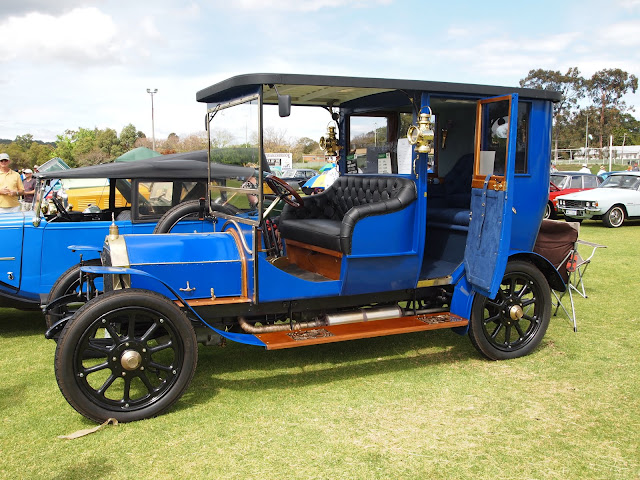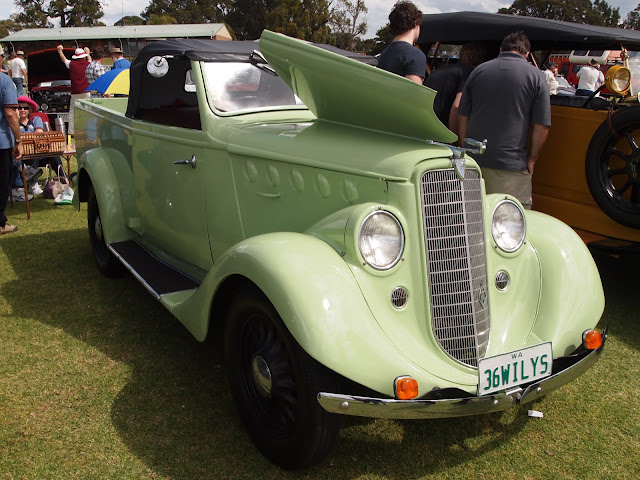
Langley Park on the Perth foreshore was once the site of Perth's first aerodrome. Passenger services were offered in the early 1920s before a formal airport was established at Maylands. As Langley Park was built over reclaimed marshland it was never built over and has remained a strip of green parkland alongside the Swan River. In recent years Langley Park's heyday as an airfield have been revived via the hosting of the Red Bull Air-race and the Langley Park Fly-In. The Fly-In sees light aircraft owners fly in and display their planes on Langley Park.

The older aircraft were concentrated at the western end of the Park. The blue aircraft is a DeHavilland DH83 Fox Moth owned by my great uncle, John Markham. It is quite a famous aircraft being the first aeroplane to land in the Shetland Islands in 1933. It was later shipped out to Australia where in 1935 it became the first aircraft operated by the Flying Doctor Service, flying out of Port Hedland. The Flying Doctor went on to become an essential and iconic public service that even today continues to provide medical services to the rural townships and stations scattered across the vast, empty wilderness that is Western Australia.
http://www.airwaysmuseum.com/Flying%20doctor%20c.50s%208.htm

In 1959 the plane was due to be replaced by the new Cessna's the Flying Doctor were purchasing. At any rate the plane was damaged in a taxiing accident and retired. It was repaired and changed hands a couple of times before being written off in an accident in 1964. John Markham later acquired the wreck and had it restored in New Zealand.

The Fox Moth is a gorgeous plane and has been displayed around the country on a number of occasions. John piloted the plane to the first Langley Park Fly-in several years ago (above).

The ubiquitous De Havilland Tiger Moth. First built as a trainer and general purpose aircraft in 1931. Although production ceased in 1959 the Tiger Moth's beautiful handling characteristics meant it continued in use long after it should have been replaced by modern aircraft. Most Second World War pilots in the Commonwealth armed forces learnt to fly in a Moth.

The Silver Centenary 1930. This was an amateur-built aircraft by an engineer named Selby Ford. It was restored and owned by Ford's grandson.

This 1932 Pietenpol is another amateur-built aircraft, this time from the USA. It was actively flown until 1938 and then stored in a shed. It was discovered and restored in 1965 and then again in the late 1990s by its current owners.

I think this looks like a Boeing-Stearman Kadyet. These were a popular training aircraft in the 1930s.

A Waco YMF-5. Waco built private use and training biplanes in the 1930s and 1940s. In 1986 production of the popular YMF-5 model recommenced and they still manufacture these sporting biplanes today. http://www.wacoclassic.com/


One of the most beautiful executive aircraft of the 1930s - the Stinson V77 Reliant. http://www.edcoatescollection.com/ac1/austu/VH-UXL.html

De Havilland Chipmunk trainer. The Chipmunk was developed by De Havilland Canada in 1946 as a replacement trainer for the aging Tiger Moth. It proved to be a successful and popular aircraft and was exported to many countries. http://www.edcoatescollection.com/ac1/austmz/VH-RHW.html


North American T-6 Texan/Havard trainer. First flown in 1935 these popular training aircraft remained in production until the early 1950s.

A Chinese Nanjang CJ-6. These are a Chinese built version of the Soviet Yak-18A. They are now being used in a number of cities for mock dogfight joyrides.

An amateur-built Culp Special. http://www.airport-data.com/aircraft/photo/063317.html


This plane performed some stunt flying while we were there. It was the plane leaving the smoke trail in the last photo.

This was one of the racers that flew in the Red Bull air-races. The Red Bull air-race over the Swan River was cancelled this year after a crash during the lead up to last year's race. http://www.perthnow.com.au/news/red-bull-plane-crashes-into-swan-river/story-e6frg12c-1225854120441

Scottish Aviation SK61 Bulldog. Built as a general purpose and training aircraft. This one is wearing the markings of the Swedish Royal Airforce.

There were three of these unusual canard winged machines on the landing strip. I think it is a Rutan-Long EZ. These are sold in kit form. Oddly they were all resting in this nose down position with the front wheel folded up. http://www.ez.org/

The owner and his son (presumably) lift the nose and drop the front wheel in preparation for take off. The plane appears to be very light as it was supported entirely by the son while the wheel was lowered into place.

Bede BD-5 kit aircraft. Another interesting space age design with swept wings and pusher propeller.

More acrobats

The Cri-Cri micro-light is the smallest aircraft with an enclosed cabin. Personally, I would never trust my life to such a seemly flimsy machine. The engines are tiny little two stokes.

When we saw this parked up at the end of the runway we were a little excited - a Supermarine Spitfire!! But no, once we got closer it was apparent it was a recreation. I'm not sure what it is exactly but a real Spitfire is much bigger than this.

John's Fox Moth taxis past the mock Spitfire as the display packs up.

Aerobatic displays in action






















































